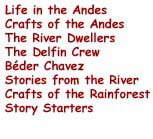

|
Wednesday, November 15, 2000 Water Quality Tamara has been monitoring the water properties in the Reserve throughout her study. She has data on the pH, temperature, turbidity, width and depth of the various bodies of water within the Reserve.
As anyone who owns an aquarium or fish bowl knows, algae must be kept in check in order to "keep a healthy tank." Too much algae can deplete the water of oxygen, making it impossible for aquatic animals to survive. In a balanced ecosystem, algae are kept in check because the limited amount of nutrients available in the water goes to supporting other plant growth. When excess nutrients like phosphate and nitrate are added to the system, an algae bloom occurs. This bloom in turn uses the available oxygen making it unavailable to other plants and animals. Additionally, too many decaying plants and animals in a water system can cause an increase in bacteria. Because bacteria use oxygen there is then less oxygen available for other plants and animals. GREEN Tamara purchased a water quality kit from The Global Rivers Environmental Education Network (GREEN). GREEN helps people monitor their local water quality with inexpensive, non-toxic and easy-to-use kits. You may want to get a similar kit to test water quality in a local steam or pond. The GREEN kit tests the following parameters: coliform, dissolved oxygen, biochemical oxygen demand (BOD), nitrate, pH, phosphate, temperature and turbidity. Coliform Bacteria Fecal coliform bacteria are naturally present in the human and animal digestive tracts but are rare or absent in unpolluted waters. Their presence in water indicates contamination from human or animal (fecal) waste. Dissolved Oxygen (DO) All aquatic animals need oxygen to survive. Waters with consistently high dissolved oxygen levels are usually healthy and stable environments. These waters can support a wide diversity of aquatic organisms. Natural and human-induced changes can affect how much dissolved oxygen is available. High levels of bacteria from sewage or large amounts of rotting plants and animals can cause a decrease in DO. Biochemical Oxygen Demand (BOD) BOD is a measure of the quantity of dissolved oxygen used by bacteria as they break down organic wastes. In slow moving or polluted waters, much of the available dissolved oxygen is consumed by bacteria. This makes it unavailable to other organisms. Note: It takes five days to obtain the results of this test. Nitrate Nitrate is needed by all aquatic animals and plants to build protein. Nitrate is released into the water by the decomposition of dead plants and animals, the excretions of living animals and from fertilizer runoff. High levels of nitrate increase plant growth and decay, promote bacterial composition and ultimately decrease the amount of oxygen available in the water. Note: The people living around San Martin Lake do not use fertilizer on their crops. The houses do not have indoor plumbing nor do they have outhouses. pH pH is the measurement of how acidic or basic the water. (See: Tools of the Trade. Water in the Amazon tends to be more acidic than our northern waters due to the tannic acid in the jungle soil. Note: An expected pH here would be between 5 and 6. Phosphate Phosphate is a nutrient needed for plant and animal growth. Levels can become too high and lead to an overgrowth of plants, increased bacterial activity, and ultimately, decreased oxygen levels. Like nitrate, one source of phosphate is human and animal waste. While Tamara must continue to use the same tools she has used all along to maintain the consistency of her measurements, the Virtual Explorers are using probes attached to their Palm handheld computers to measure pH and temperature. They are comparing their data with the data collected by Tamara. Fishing Nets and Cages In addition to counting dolphins and measuring water quality, Tamara also counts the number of fishnets and cages she finds in the lake. Fishing Nets: About a year ago, commercial-fishing nets became popular in the area. Previously, the people who used them made nets from natural fibers. The commercial nets are made from monofilament and don't break under the load of large catches or from species that thrash wildly when caught.
The last six months of water data for San Martín Lake are back in Iquitos. We will post those here as soon as we return so that you can draw your own conclusions about the water quality in the lake and how it may or may not be changing. Location: Water collected from San Pablo Ox Bow Lake
Ranking Test Results
|




